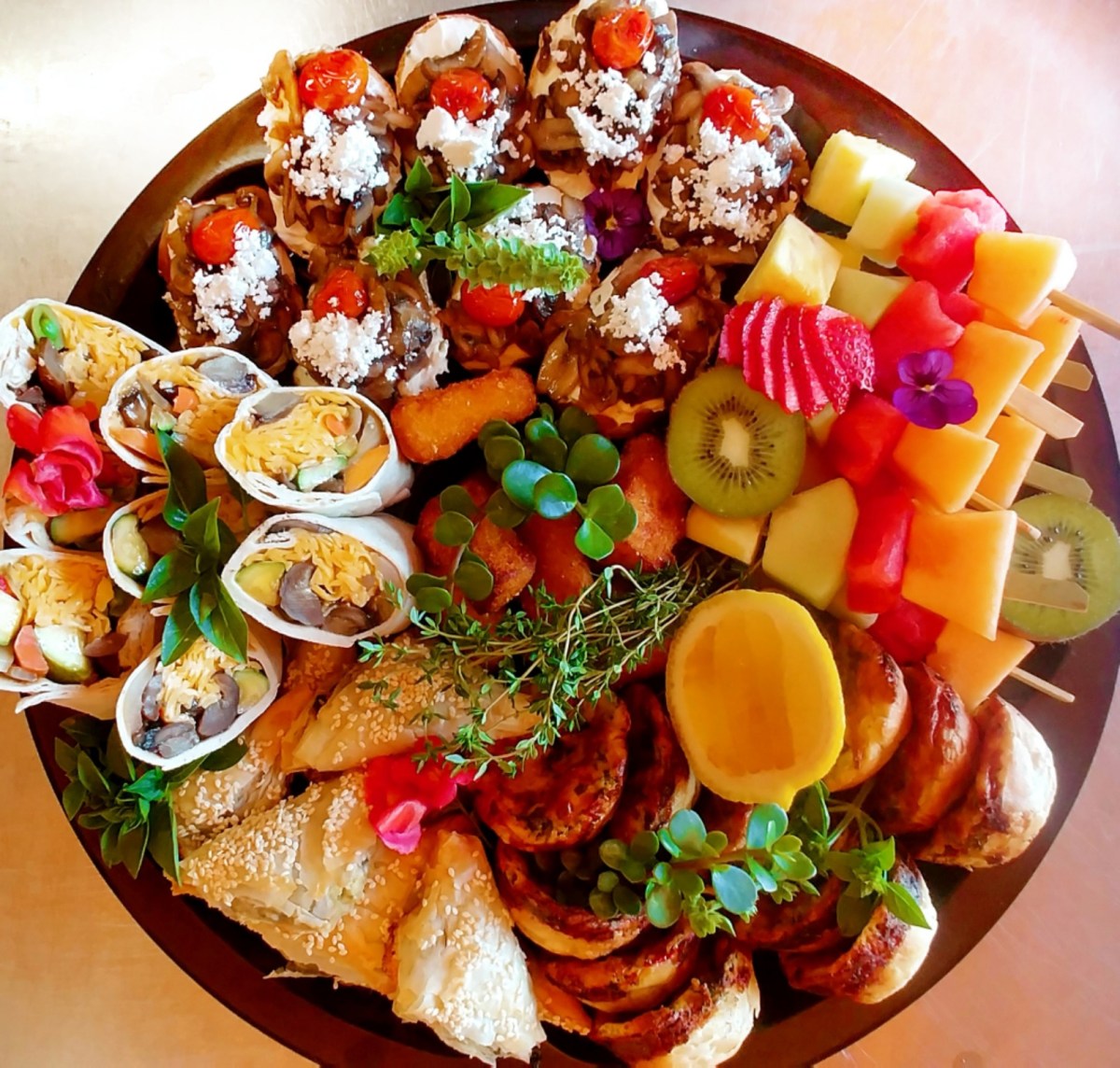Imagine a vibrant tapestry of colors, textures, and flavors—that’s the essence of a perfectly crafted vegetarian charcuterie board. Forget the limitations of meat-centric platters; this guide unlocks a world of creative possibilities, transforming a simple gathering into a feast for the eyes and palate. We’ll explore diverse ingredients, stunning presentation techniques, and tantalizing flavor combinations, ensuring your next party boasts a vegetarian charcuterie board that’s both breathtaking and delicious.
From carefully selected cheeses and vibrant fruits to crunchy nuts and flavorful spreads, we’ll delve into the art of building a vegetarian charcuterie board that caters to diverse tastes and dietary needs. Learn how to balance sweet, salty, sour, and bitter notes, creating a harmonious symphony of flavors that will leave your guests wanting more. We’ll also guide you through homemade recipes for dips, spreads, and even crackers, adding a personal touch to your culinary masterpiece.
Creative Presentation and Arrangement Techniques

A vegetarian charcuterie board’s success hinges not only on delicious ingredients but also on its captivating visual appeal. Strategic arrangement, thoughtful use of color and height, and creative presentation techniques transform a simple spread into a culinary masterpiece, inviting guests to explore a vibrant landscape of flavors and textures. The following sections detail how to achieve a visually stunning vegetarian charcuterie board that will impress even the most discerning palate.
Three Unique Vegetarian Charcuterie Board Arrangements
Three distinct approaches can elevate the visual impact of your vegetarian board. Consider these options to inspire your own creative compositions:
- The Garden Patch: Imagine a vibrant garden scene spilling onto your board. Cluster vibrant vegetables like cherry tomatoes, bell peppers (sliced into various shapes and colors), and artichoke hearts together in one area, creating a burst of color. Use sprigs of fresh herbs like rosemary and thyme to add texture and visual interest, acting as natural dividers between sections. Arrange creamy cheeses, like goat cheese and ricotta, in small bowls nestled amongst the vegetables, mimicking blooming flowers. Scatter toasted nuts and seeds for a textural contrast and earthy tones.
- The Mediterranean Escape: Transport your guests to the sun-drenched shores of the Mediterranean. Begin by creating a base of olives and marinated artichoke hearts, forming a dark, earthy foundation. Then, arrange vibrant spreads like hummus and baba ghanoush in small, shallow bowls. Intersperse slices of crusty bread and pita triangles. Add bright pops of color with sun-dried tomatoes, roasted red peppers, and wedges of citrus fruits like oranges or lemons. A sprinkle of fresh oregano and a drizzle of olive oil add an authentic touch.
- The Rainbow Harvest: Embrace a spectrum of colors for a visually stunning board. Organize your ingredients by color, creating a rainbow effect. Start with reds (tomatoes, red peppers), followed by oranges (carrots, sweet potatoes), yellows (squash, corn), greens (lettuce, spinach, olives), blues (blueberries, eggplant), and purples (red cabbage, purple grapes). Use different heights and textures, such as a tall bowl of hummus, to break up the color blocks and add visual interest. The variety in color and texture creates a dynamic and visually engaging presentation.
Utilizing Height and Color Variation for Visual Appeal
Height and color are powerful tools for creating a visually appealing charcuterie board. Varying heights adds depth and dimension, preventing a flat and uninteresting presentation. Color variation provides visual excitement and guides the eye across the board. For instance, use different serving dishes: a tiered stand allows for a cascading effect, with taller items like crudités or a small salad in the back and shorter items like crackers and cheeses in the front. Small bowls can hold dips, while larger platters showcase slices of bread and vegetables. Strategically placing brightly colored items like roasted red peppers or colorful fruits next to more muted colors, like olives or nuts, enhances the overall visual harmony. The contrast creates visual interest and guides the eye through the different elements of the board.
Step-by-Step Guide to Assembling a Circular Vegetarian Charcuterie Board
Creating a circular vegetarian charcuterie board offers a unique and elegant presentation. Follow these steps to assemble a visually stunning board:
- Prepare your ingredients: Wash and chop all vegetables, slice cheeses, and arrange all your components in separate containers within easy reach.
- Create the base: Start by placing a large, round platter or wooden board in the center of your work area. Arrange a ring of larger items – perhaps a selection of colorful vegetables like roasted red peppers and zucchini slices – around the perimeter, creating a visual border.
- Add dips and spreads: Place bowls of dips and spreads – hummus, baba ghanoush, or a white bean dip – at regular intervals around the board, nestled amongst the vegetables. The bowls provide a nice textural contrast to the flat elements.
- Incorporate height: Use small bowls or ramekins to add height and visual interest. Fill these with nuts, seeds, or dried fruits. You can also arrange small piles of crackers and breadsticks around the board.
- Fill in the gaps: Strategically place smaller items – olives, marinated artichoke hearts, grapes – to fill in any gaps and create a cohesive and visually pleasing design. Consider color and texture when placing these items.
- Garnish and finish: Add finishing touches such as fresh herbs (rosemary, thyme), edible flowers, or a sprinkle of flaky sea salt. This adds a final layer of visual appeal and fragrance.
Imagine a large, rustic wooden board, the circumference adorned with vibrant slices of bell peppers in shades of red, orange, and yellow. Nestled between the peppers are small bowls of creamy hummus and vibrant green pesto, their smooth surfaces contrasting with the rough texture of the board. Scattered throughout are plump olives, artichoke hearts, and clusters of sun-dried tomatoes, their deep colors adding depth and richness to the arrangement. Small piles of crackers and crusty bread are strategically placed, providing a textural contrast and creating pockets of empty space that allow the eye to appreciate the vibrant colors and textures of the other ingredients. A final touch of fresh rosemary sprigs adds a touch of elegance and aroma.
Flavor Combinations and Pairing Suggestions
Crafting a truly delightful vegetarian charcuterie board hinges on the artful interplay of flavors. A successful board isn’t just about a pretty arrangement; it’s about a carefully orchestrated symphony of tastes that dance on the palate. The key lies in achieving a balanced profile, incorporating sweet, salty, sour, bitter, and umami notes to create a captivating and memorable experience for your guests.
The importance of balancing sweet, salty, sour, and bitter flavors on a vegetarian charcuterie board cannot be overstated. This balance prevents any single flavor from overpowering the others, creating a harmonious and enjoyable tasting experience. A board that’s solely sweet, for instance, will quickly become cloying, while one that’s excessively sour will be unpleasant. The ideal balance allows each flavor to complement and enhance the others, leading to a more complex and satisfying culinary journey.
Five Flavor Combinations for Vegetarian Charcuterie Boards
Below are five distinct flavor combinations, each offering a unique and delicious profile. These suggestions provide a starting point for creating your own customized boards, encouraging experimentation and personal preference.
- Mediterranean Medley: This combination features the bright, herbaceous notes of sun-dried tomatoes, Kalamata olives, marinated artichoke hearts, creamy feta cheese, and crusty bread. The salty olives and feta contrast beautifully with the sweetness of the sun-dried tomatoes, while the artichoke hearts add a subtle earthiness. A drizzle of high-quality olive oil adds richness and visual appeal.
- Spicy Southwestern Fiesta: A vibrant board featuring roasted sweet peppers, black beans, corn salsa, creamy avocado, tortilla chips, and a spicy mango salsa. The sweetness of the peppers and mango is balanced by the saltiness of the tortilla chips and the heat of the salsa. The creamy avocado provides a textural counterpoint.
- Earthy Autumn Abundance: This combination celebrates the flavors of fall. Imagine roasted butternut squash, toasted pecans, crumbled goat cheese, fig jam, and crackers. The sweetness of the squash and fig jam is beautifully balanced by the salty goat cheese and the earthiness of the pecans. The crackers provide a satisfying crunch.
- Creamy Italian Delight: This board showcases the rich flavors of Italy. Include marinated mushrooms, roasted red peppers, fresh mozzarella, pesto, and crostini. The creamy mozzarella contrasts with the earthy mushrooms and the vibrant pesto, while the roasted peppers add a touch of sweetness. The crostini provides a crisp base for the various components.
- Asian-Inspired Harmony: This combination offers a unique twist. Consider edamame, pickled ginger, crispy seaweed sheets, various types of Asian-style crackers, and a creamy peanut sauce. The salty seaweed and edamame complement the sweetness of the pickled ginger, while the peanut sauce adds a rich and savory element. The crackers provide a pleasing texture.
Ten Vegetarian Dips and Spreads with Pairing Suggestions
A well-chosen selection of dips and spreads elevates any vegetarian charcuterie board. They add depth of flavor and textural variety, providing a cohesive experience. The following dips offer a range of flavor profiles to complement various board components.
- Hummus (Classic): Earthy and creamy, pairs well with pita bread, vegetables, and crackers.
- Baba Ghanoush (Smoky): Smoky and slightly tangy, complements grilled vegetables and pita bread.
- White Bean Dip (Garlic & Herb): Savory and herbaceous, ideal with crusty bread and crudités.
- Roasted Red Pepper Dip (Sweet & Smoky): Sweet and smoky, pairs well with crackers and pita chips.
- Muhammara (Spicy Walnut Dip): Spicy and nutty, a fantastic accompaniment to vegetables and pita bread.
- Sun-dried Tomato Pesto (Tangy & Herbaceous): Tangy and vibrant, excellent with crostini and vegetables.
- Fig Jam (Sweet & Fruity): Sweet and fruity, complements cheeses and crackers.
- Guacamole (Creamy & Spicy): Creamy and subtly spicy, pairs perfectly with tortilla chips and vegetables.
- Spicy Carrot Dip (Sweet & Spicy): Sweet and spicy, a great choice with pita bread or crackers.
- Olive Tapenade (Savory & Briny): Savory and briny, enhances the flavors of crusty bread and olives.
Creating a stunning and delicious vegetarian charcuterie board is more than just arranging ingredients; it’s about crafting an experience. By thoughtfully selecting ingredients, mastering presentation techniques, and understanding flavor pairings, you can transform a simple appetizer into a show-stopping centerpiece. Remember to consider dietary restrictions and embrace creativity—let your board reflect your personal style and the unique tastes of your guests. With a little planning and inspiration, your next party will be remembered for its unforgettable vegetarian charcuterie board.
Frequently Asked Questions
What are some good substitutes for brie cheese if someone is lactose intolerant?
Excellent dairy-free alternatives to brie include cashew-based cheeses, which offer a similar creamy texture and mild flavor. Some brands even mimic the rind for a more authentic experience.
How far in advance can I prepare a vegetarian charcuterie board?
Many components, like cheeses, fruits, vegetables, and nuts, can be prepped a day or two ahead. However, assemble the board just a few hours before serving to maintain freshness and prevent wilting.
What’s the best way to store leftover charcuterie board items?
Store leftover items separately in airtight containers in the refrigerator. Remember that some items, like certain cheeses and dips, might not store as well as others.
How can I make my vegetarian charcuterie board visually more appealing?
Use a variety of heights and colors. Incorporate different serving dishes, such as small bowls, tiered stands, and even small cutting boards. Consider adding edible flowers or herbs for a pop of color and visual interest.


